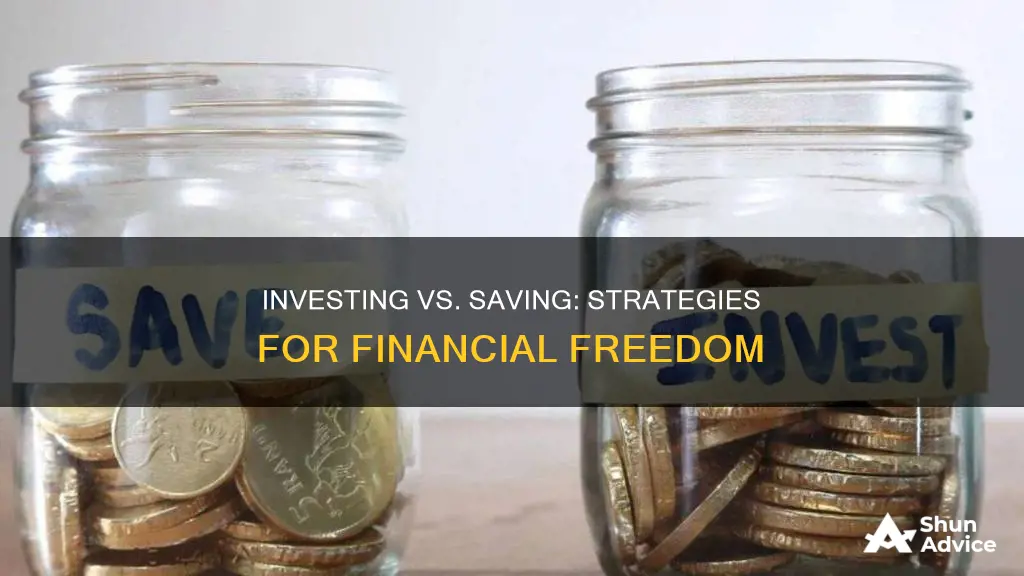
Saving and investing are both important concepts for building a sound financial foundation, but they are not the same thing. While both can help you achieve a more comfortable financial future, it's essential to understand the differences and know when it's best to save and when it's best to invest. The biggest difference between the two is the level of risk taken. Saving typically results in a lower return but with almost no risk, whereas investing allows for the opportunity to earn a higher return, but you take on the risk of loss.
| Characteristics | Values | |
|---|---|---|
| --- | --- | --- |
| Risk | Saving: Low | Investing: High |
| Returns | Saving: Low | Investing: High |
| Liquidity | Saving: High | Investing: Low |
| Time horizon | Saving: Short-term | Investing: Long-term |
| Goals | Saving: Short-term, emergency fund, purchases | Investing: Long-term, retirement, education |
| Asset types | Saving: Cash, savings accounts, CDs | Investing: Stocks, bonds, mutual funds, ETFs, real estate, cryptocurrency |
| Tax treatment | Saving: Interest income taxed | Investing: Capital gains and dividend income taxed at a lower rate |
What You'll Learn

Saving for emergencies, investing for long-term goals
Saving for emergencies and investing for long-term goals are two different but complementary strategies for achieving financial security. Here's how they differ and how they can work together to help you build wealth:
Saving for Emergencies
Saving is a crucial component of financial planning, especially when it comes to building an emergency fund. The general rule of thumb is to save enough to cover living expenses for three to six months in a dedicated emergency fund. This money should be kept in a safe, easily accessible account, such as a high-yield savings account, money market account, or a certificate of deposit (CD). These accounts offer liquidity, minimal risk, and modest returns, making them ideal for short-term goals. By prioritising saving, you can ensure you have a financial safety net for unexpected events and expenses.
Investing for Long-Term Goals
Investing, on the other hand, is all about growing your wealth over time. This typically involves taking on more risk by allocating your money across various financial instruments, such as stocks, bonds, mutual funds, or exchange-traded funds (ETFs). The goal is to achieve higher returns than what you'd get from a typical savings account, but it comes with the possibility of losing some or all of your investment. Investing is most suitable for long-term goals with a time horizon of at least three to five years, if not more. This longer timeframe allows you to ride out the inevitable ups and downs of the financial markets and potentially achieve higher returns.
Combining Saving and Investing
While saving and investing serve different purposes, they work best when used together. Here's how you can combine them effectively:
- Build an Emergency Fund First: Before investing, prioritise saving and build an emergency fund that covers your living expenses for three to six months. This ensures you have a cushion to fall back on during unexpected events, such as a job loss or medical emergency.
- Prioritise Long-Term Investments: Once you have a solid emergency fund in place, shift your focus to investing for long-term goals. This could include retirement planning, saving for a child's education, or any other goal with a long time horizon.
- Diversify Your Investments: When investing, it's crucial to diversify your portfolio by allocating your money across different asset classes, such as stocks, bonds, and cash. Diversification helps manage risk and improve your potential for long-term growth.
- Maintain a Balanced Approach: Don't put all your money into risky investments, even for long-term goals. Maintain a balanced portfolio that aligns with your risk tolerance and financial goals. Regularly review and adjust your investments to ensure they continue to meet your needs.
- Start Early: Both saving and investing are most effective when started early. The power of compound interest means that even small contributions to a savings or investment account can grow significantly over time.
In summary, saving for emergencies and investing for long-term goals are complementary strategies for achieving financial security. Saving provides a safety net for unexpected events, while investing offers the potential for higher returns over the long term. By combining these strategies effectively, you can build wealth, protect against financial shocks, and work towards a more secure financial future.
Who Pays for Investment Advice?
You may want to see also

Saving for short-term goals, investing for retirement
Saving for short-term goals and investing for retirement are two distinct financial strategies, each serving different purposes. Here's a detailed overview:
Saving for Short-Term Goals
Short-term financial goals typically refer to objectives you want to achieve within a year or less. Examples include saving for a new gadget, a vacation, or building an emergency fund for unexpected expenses. When saving for short-term goals, it's essential to choose low-risk options that offer liquidity and easy access to your funds. Here are some strategies to consider:
- High-Yield Savings Accounts: These accounts offer higher interest rates than traditional savings accounts, allowing your money to grow faster. They are easily accessible through online platforms, and some even provide ATM cards or checkbooks.
- Money Market Accounts: Similar to high-yield savings accounts, money market accounts often come with additional access options like ATM cards or checkbooks. They usually have higher interest rates than regular savings accounts but may also require higher minimum balances.
- Certificates of Deposit (CDs): CDs offer a fixed interest rate for a specific period, typically one, three, or five years. They provide a higher interest rate than regular savings accounts but restrict early withdrawals, which may result in penalties.
- Treasury Bills (T-bills): T-bills are low-risk, short-term government bonds with terms ranging from a few days to one year. You can buy T-bills in $1,000 increments and redeem them with interest quickly.
- I Bonds and EE Bonds: These are types of low-risk government bonds designed for long-term savings. I bonds can be redeemed after 12 months, but early redemption results in losing some interest. EE bonds earn interest monthly and guarantee that your balance will double in 20 years.
Investing for Retirement
Retirement investing is a long-term strategy, typically spanning several decades. The goal is to grow your wealth over time and generate income for your post-retirement life. Here are some key considerations:
- Retirement Accounts: Open a retirement account such as an IRA or 401(k) to benefit from tax advantages. Contributions to these accounts may be tax-deductible, and the investments grow tax-deferred, allowing your money to compound without immediate tax implications.
- Employer Matching: If your employer offers a 401(k) plan with matching contributions, ensure you contribute enough to receive the full match. This is essentially "free money" toward your retirement savings.
- Stocks, Bonds, and Mutual Funds: Investing in the stock market offers the potential for higher returns but comes with higher risk. Consider a diversified portfolio of stocks, bonds, and mutual funds to balance risk and return. You can also invest in exchange-traded funds (ETFs), which are similar to mutual funds but trade on exchanges like stocks.
- Long-Term Time Horizon: Retirement investing is typically a long-term endeavour. The longer you invest, the more time your portfolio has to recover from any short-term losses. Historically, the stock market has rewarded long-term investors with positive returns.
- Risk Tolerance: Assess your risk tolerance and adjust your investments accordingly. As you approach retirement age, consider shifting a portion of your portfolio to more conservative investments like bonds to reduce risk.
- Financial Advisors: Consider working with a financial advisor or using robo-advisory services to guide your investment choices and help you stay on track toward your retirement goals.
Elon Musk's Shiba Inu Conundrum: Why He May Take the Plunge
You may want to see also

Saving is low-risk, investing is higher-risk
Saving and investing are both important components of a healthy financial plan. However, they are distinct concepts with different levels of risk and return. Saving typically involves storing money in a bank account or other secure place, providing easy access and a low-risk way to accumulate funds for short-term goals and unexpected expenses. On the other hand, investing involves using money to purchase assets, such as stocks, bonds, or real estate, with the expectation of earning profits or achieving long-term financial goals.
When you save money, you are prioritising safety and liquidity. Savings accounts often offer a low but guaranteed return, with minimal risk of losing value. This makes saving ideal for short-term financial goals and building an emergency fund. By setting aside a portion of your income regularly, you can ensure that you have funds available for unexpected costs, such as car repairs or medical bills. Additionally, saving can help you avoid taking on high-interest debt by providing a readily available source of cash.
In contrast, investing involves taking on higher risk in pursuit of higher returns. When you invest, you purchase assets with the hope that they will increase in value over time. However, there is always the possibility of losing some or all of your investment. Investing is better suited for long-term goals, such as retirement or saving for your children's education, as it provides the potential for greater wealth accumulation. By investing in stocks, bonds, mutual funds, or other assets, you can aim for returns that outpace inflation and grow your money over time.
While saving offers security and immediate access to your funds, investing provides the opportunity for higher returns and long-term growth. It's important to understand the differences between these two strategies and incorporate both into your financial plan. Saving can provide a solid foundation for your financial goals, while investing can help you achieve those goals faster and build long-term wealth. Ultimately, the right balance between saving and investing depends on your financial situation, goals, and risk tolerance.
Wholesaling: Supercharging Your Investment Strategy
You may want to see also

Saving for purchases, investing to grow money
Saving for purchases and investing to grow your money are two distinct financial strategies, each with its own advantages and disadvantages. Here's a detailed overview:
Saving for Purchases
Saving is an essential financial strategy that involves setting aside money for future use. It is a conservative approach that prioritises the preservation of capital over potential gains. When you save, you typically utilise financial instruments like savings accounts, money market accounts, or certificates of deposit (CDs). These options offer a low-risk way to accumulate funds for short-term goals and unexpected expenses. Here are some key considerations:
- Safety and Liquidity: Savings accounts offer a safe place to store your money, often with FDIC insurance protecting your funds. They also provide easy access to your money, allowing you to withdraw funds as needed without significant barriers.
- Low Risk, Low Returns: Savings accounts generally carry minimal risk, ensuring your principal remains intact. However, the trade-off is that you earn lower returns compared to riskier investments.
- Protection Against Inflation: Inflation can erode the purchasing power of your savings over time. While savings accounts may not offer high returns, they can help protect your money from losing value due to inflation.
- Short-Term Goals: Saving is ideal for short-term financial goals, such as purchasing a car, saving for a down payment on a house, or covering emergency expenses. It ensures that you have readily available funds when needed.
- Financial Discipline: Saving regularly requires financial discipline and attention to expenses. It encourages you to manage your discretionary spending and build a cushion for unexpected situations.
Investing to Grow Your Money
Investing, on the other hand, is a strategy focused on growing your money over time. It typically involves purchasing various financial instruments, such as stocks, bonds, mutual funds, or exchange-traded funds (ETFs). Investing carries a higher level of risk than saving but also offers the potential for higher returns. Here's what you should know:
- Potential for Higher Returns: Investing in the stock market, for example, has historically provided average annual growth rates of about 7% after inflation. This means your investments can potentially double in value every 10.5 years.
- Long-Term Goals: Investing is suitable for long-term financial goals, such as retirement planning, saving for your children's education, or achieving generational wealth. It gives your money more time to grow and compound.
- Risk and Volatility: Investing carries the risk of losing money. The value of your investments can fluctuate due to various factors outside your control. It's important to assess your risk tolerance and ensure you are comfortable with potential losses.
- Time Horizon: Investing is generally recommended for money you won't need for at least five years or longer. This longer time horizon helps to mitigate the impact of short-term market volatility and increases the potential for gains.
- Diversification: To manage risk effectively, diversification is key. Diversifying your investments across different asset classes and industries can reduce the overall risk of your portfolio.
In conclusion, saving for purchases and investing to grow your money are both essential components of a comprehensive financial plan. Saving provides financial security and flexibility for short-term goals, while investing offers the potential for higher returns over the long term. It's important to understand the differences between these strategies and utilise them appropriately to achieve your financial objectives.
America's Rail Travel Resistance: Why Investment Isn't On Track
You may want to see also

Saving in a bank, investing in stocks, bonds, etc
Saving and investing are both important concepts for building a sound financial foundation, but they are not the same thing. Saving typically results in lower returns but with virtually no risk, while investing allows for higher returns but comes with the risk of loss. Both are important components of a healthy financial plan, and it's crucial to understand the differences between the two to make informed decisions about your money.
When you save money in a bank account, you are prioritising the preservation of your capital with minimal risk. Bank accounts, such as savings accounts, money market accounts, and certificates of deposit (CDs), offer a safe place to store your money with easy access and liquidity. These accounts are ideal for short-term financial goals, unexpected emergencies, and immediate or near-term expenses. They provide a financial safety net and help you build a cushion to weather tough times. However, the returns on these accounts are generally low, and you may lose purchasing power over time due to inflation.
On the other hand, investing in stocks, bonds, mutual funds, or exchange-traded funds (ETFs) is a way to grow your money over time. Investing involves taking on some level of risk, but it also offers the potential for higher returns. It is a powerful tool for achieving long-term financial goals, such as saving for college, a down payment on a house, or retirement. By investing in diverse assets and holding them for the long term, you can increase your chances of beating inflation and growing your wealth. However, investing requires discipline and a long-term perspective, and there is always the risk of losing money.
To summarise, saving in a bank is ideal for short-term goals and provides easy access to your funds with minimal risk. In contrast, investing in stocks, bonds, and other financial instruments is better suited for long-term goals and offers the potential for higher returns but comes with the risk of loss. Both saving and investing play a crucial role in financial planning, and it's important to find the right balance between the two based on your financial situation, goals, and risk tolerance.
Cohabiting Couples: Avoid Joint Investments
You may want to see also
Frequently asked questions
Saving is putting money aside in a secure place, like a savings account, for future use. Investing, on the other hand, involves buying assets with the expectation that they will increase in value over time.
It is generally recommended to save money if you don't have an emergency fund, need the cash within the next few years, or are carrying high-interest debt.
Investing offers the potential for higher returns than saving, making it suitable for long-term financial goals such as retirement or saving for a child's education.







